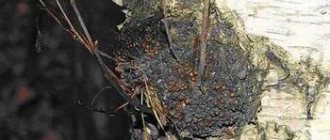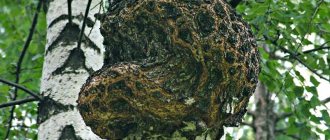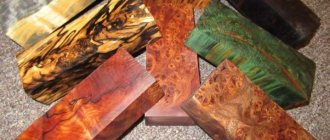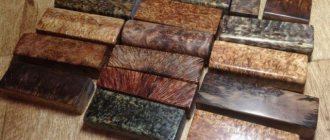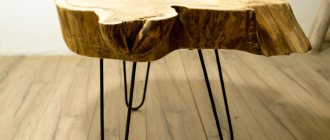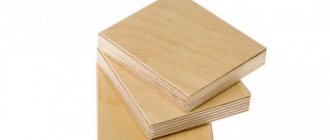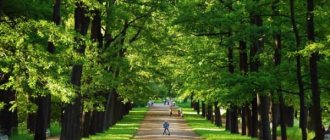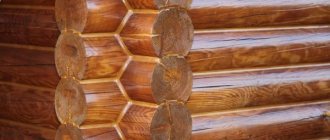A burl is also called a “witch’s broom” - it is a small formation on a tree of a benign nature. Basically it has the form of a drop from which thin branches grow, collected in a bunch. In the cross section, you can observe a structure of striking knots. Processing the burl is not easy, although it can still be ground and polished. The result of the work has a very attractive appearance.
Some areas of birch burl may have a mother-of-pearl appearance. In industry it is not of particular value, but is quite expensive due to its beauty and uniqueness.
Sometimes burl can be used as a veneer for furniture, but most often it is burl from exotic trees. But birch burl is used to make beautiful boxes, small women’s jewelry or hairpins, and cigarette cases.
Birch burl has a high-quality texture, so a knife with a wooden handle is very beautiful and expensive.
It is impossible to find two identical burls in nature; even the halves differ from each other. They can be seen on many different trees. In our latitudes, birch burl is highly valued. It does not grow large, the maximum diameter is like that of a large plate.
Due to the dense texture, it is difficult to make any design on the mouth guard, and there is no point.
So that the birch burl can be used for its intended purpose in the future, it is very important to assemble it correctly. To do this, we will provide you with detailed instructions:
Correct processing of birch burl
Very often, when sawing a burl, a unique and inimitable pattern is formed that the master will not want to change. In other cases, the burl after sawing is processed:
- Large burls are almost always sawn, since several items can be made from it at once. The burl is divided into several plates, the thickness of each depends on what kind of object you plan to make.
- In order to get an excellent drawing in the future, you should think about the cutting angle in advance. The more sleepers there are on the cut, the better.
- When the burl is fresh, the pattern appears weakly, but sawing is much easier.
- To ensure that the drawing appears in full beauty, the cap should be thoroughly steamed before making the item.
- You can steam the burl at home; fine sawdust is suitable for this. To carry out the procedure, take a container of the required size (it is recommended to use an old pan, since the dyes that will appear cannot be washed off). The sawdust is spread in a generous layer on the bottom, and a drip is placed on top. You cannot lay them tightly; there must be a gap of at least 0.5 centimeters. Sawdust is sprinkled on top in a thin layer.
- The placed cap is poured into a saucepan with well-salted water (mostly the bottom layer). The water should not completely cover the workpieces, but only touch them a little. Salt is taken at the rate of 1 tbsp. l. for 1 liter of water. If it’s a little more, it doesn’t matter.
- The prepared cap is covered with a lid and placed on low heat. As soon as the mixture boils, count for about 10 hours and allow the burl to steam well. To avoid troubles, look into the container every hour and add water if necessary.
- After a while, remove the container from the heat and leave to cool.
- After cooling, the workpieces are washed under running water and left to dry. To ensure they dry evenly, they should be turned over every few hours. The drying period lasts about 3-4 days.
- When the workpieces are completely dry, they are again steamed according to the above scheme and dried again. The procedure is repeated up to three times.
- If after steaming the bark does not fall off completely, it is carefully removed by hand.
- It is preferable to carry out the drying procedure outside. The first day they turn it over quite often, on the third day 1-2 times is enough.
- It’s great if it is possible to carry out final drying in a special oven several times.
- If the drip is very large (larger than a basketball), this type of treatment will not work. The drying or steaming process may cause cracks and other damage.
- Boiled as basically divided into parts. Solid growths on birch are processed like ordinary wood - by sanding and varnishing.
- When evaporated, the burl plates acquire the shade of the released components; it can be very diverse (yellow with a golden tint, brown, etc.).
- After treatment, subsequent procedures can be carried out, for example, varnishing or painting.
- Before varnishing, the surface is sanded well using coarse sandpaper, then fine sandpaper. Wood dust is wiped off with a soft cloth.
- The design will appear in all its glory if the tray is treated with wax.
In fact, working with a burl is very painstaking, requiring attention and a lot of time. But what comes out of the work is certainly pleasing. Birch burl makes excellent souvenirs that have an individual and unique design.
Birch suvel, or, as it is often called popularly, tree bone, is a unique natural formation that is of great value to craftsmen. After processing this material, carvers make beautiful wooden products. In the article we will look at what birch suvel is and what it is used for.
Making boxes
Crafts made from birch burl are not inferior in beauty to souvenirs made from wood and even surpass them. Magnificent boxes are often made from this material.
During the work process, the burl boards are carefully connected to each other, making sure that their texture pattern is similar. A very important operation is the manufacture of wooden hinges. This step requires the precise formation of rounded tenons and grooves on the edges of the lid and body of the product. The hinges must fit tightly and accurately. Another difficult operation is drilling holes. In wooden hinges this is easiest to do with thin steel wire. At the next stage, a lock is cut into the box. The product is almost ready. It should only be puttied, thoroughly dried and the surfaces coated with alkaline varnish. After completing these works, the box is treated with polish and wiped with alcohol. The product is polished until the wood acquires and until all the veins of its amazing texture shine brightly.
What it is?
Suvel (svil) is a rounded growth on the trunks of birch trees. May also occur in other breeds. It grows quite quickly. Consists of twisted or deformed wood fibers. Suveli can be located around the tree or in groups on one section of the trunk.
This material is usually harvested in windfall areas or at sawmills. The nature of the formation of growths is still not completely known. Some argue that this is due to an external influence on the tree trunk or a disease, as a result of which a hall is formed, which after some time becomes overgrown with fibers.
Causes of growths
Usually in plants they arise as a result of a sharp change in its development, which has either a natural or anthropogenic cause.
The growths sometimes appear in the form of simply round-shaped formations, and sometimes in the form of several lumps located next to each other. The latter is due to the fact that when the integrity of wood is violated for some reason, the tree tries to protect itself from various fungal diseases and insects, which is why such unimaginable forms of formations grow.
What not to be confused with?
Beginners who are not very familiar with what birch suvel is may confuse it with burl. By the way, the second one is much less common and is considered more valuable. Their main difference is the presence of knots in a longitudinal cut, a clearly visible core, a fine pattern, and pronounced ornate layers. Moreover, there are no repeating burl patterns in nature; they all have a unique design.
The surface of the suvel under the bark is smooth, less often with large bumps. In burls, it is finely pimpled, and small branches grow from it. Suveli is not so dense and is easier to process.
Value, feature
Growths on trees come in a wide variety of shapes and sizes. The burl wood of the following plants looks very beautiful: maple, cherry, pear. The growth on the walnut is considered valuable on the international market. It should be noted that there have been cases where some mouth guards with a textured pattern were valued at their weight in silver.
For the most part, growths are small in size, but there are also specimens reaching 2 meters in diameter and weighing more than one ton. Moreover, it often happened that education was completely amazing magical patterns.
In birch the growths are found to be much smaller in size than on a walnut tree. It happens that in the beauty of their patterns they are significantly superior to the latter.
Who would have thought that an ordinary knobby growth on a tree has such valuable properties!
Amazing phenomenon
When cutting a birch tree correctly, you can see amazing phenomena. To be more precise, the interweaving of wood fibers forms pearlescent areas with a unique pattern. They begin to emit a special glow when reflected from sunlight. The effect looks very beautiful in finished products, for example, in a stacked handle made of birch suvel.
The pattern and color are distinguished by their uniqueness; as a rule, it is brownish-ocher, soft pink, straw with a pearlescent sheen, and less often - dark brown with a marsh tint.
Economic importance and application
Growths on trees bring considerable benefits. Not the plant itself, no. They are used by humans in the production of various products. Burls are needed to obtain unusual wood with a unique grain texture. Due to the variety of unique designs, this material is widely in demand and used by artists, cabinetmakers and sculptors.
There is a huge variety of well-known and common types of burl used in the manufacture of veneer, beautiful interior items, board games, picture frames, household items, jewelry, etc. Such wood is not very easy to process due to its unevenness and heterogeneity in the direction of grain growth, but it is strong and durable.
Burl is also widely used in decorative arts. In Vyatka in the 19th century, folk art was created: craftsmen made Vyatka burl boxes, desk writing sets, etc.
How to collect suvel?
People just walking in the forest, picking berries or mushrooms, don’t notice at all. If you purposefully look for burls or suveli, you can see them quite often. They can be located at the foot or at the top of the trunk, where it is almost impossible to reach them without a ladder. If we talk about the terrain, it can be a swampy lowland or a sand and stone plain.
Often rotting growths are found, giving the impression that the tree is trying to get rid of the strands. If you cut off any intact part, it will also rot after a certain period of time.
The slower a tree grows in unfavorable conditions, the denser the fiber plexus and the harder the material. It is impossible to predict the design of a suveli, but the more clumsy it is, the more beautiful the pattern will be. At the same time, it is possible to make a voluminous piece from it only in exceptional cases.
Due to the fact that the material is hard, it is quite difficult to cut it down the first time; the blade quickly becomes dull. From the second run things go much faster. When harvesting birch suvel, you need to try to ensure that the cut is even and runs parallel to the trunk. To prevent the tree from dying, it is advisable to treat the cut with a wound-healing solution. It can be purchased in the garden department of the store.
If the growth encircles the trunk, then it cannot be cut down, as the tree may die.
Blank
In nature, suvel is found much more often than kapa. Trees with such lesions can be found in deciduous or mixed forests located in both dry and swampy areas. It must be taken into account that cutting a suvel or burl on a growing birch tree can lead to its death. Therefore, after cutting down the material, it is necessary to cover the living layer with varnish.
READ Where is wood ash used?
On dead trees, the formations are already affected by rot and are not suitable for production. Therefore, finding a suitable material for the workpiece is not easy. It is better to do this in mid-autumn.
It is impossible to determine by the type of formation what it will be like in the cut. But the more crooked and tortuous the suvel and the more twigs on the burl, the more saturated the pattern will presumably be. Working with such material is more difficult, but more interesting.
It is quite difficult to cut down suvel and burl, the chains become dull quickly, so good sharpening of the tool is necessary. You can cut it with a hacksaw or bow saw, but this will require a lot of physical effort.
Birch suvel has a different texture when cut. It can be pronounced or completely invisible. Suvel with a texture that is difficult to see usually has higher strength. But you will never guess by the appearance of the growth that there is a cavity or a beautiful ornate bend in it.
How to dry birch suvel?
The appearance of it, and then the finished product, depends on the method of preparing raw materials. There are several different initial processing methods. The wood can be left exposed to air in natural conditions for a year or two, or this process can be accelerated by other methods. Below we will describe a faster method.
To dry, the bark is removed from the workpiece, wrapped in newspaper in several layers, then placed in a black plastic bag. The paper prevents the material from heating up quickly; the bag creates a steam room effect. Black polyethylene quickly heats up from sunlight (when drying suvel on the street) or from a battery. The process occurs evenly, which prevents the wood from cracking. The bag needs to be tied, leaving a small opening. For the first 10 days, newspapers are changed twice a day for dry ones; for the next 15 days, once is enough. By the end of the period, the paper should remain almost dry. In general, the process takes 25-30 days, the wood retains its natural color and does not crack.
Research results
According to statistics, for every 3,000 ordinary trees, without growths, there is on average one burl tree.
Since 1959, due to the value of such wood, the Central Research Institute of Forest Genetics of the USSR Academy of Sciences began to study the biological study of burls and methods of growing them. Scientists have developed a technology for sowing and growing birch trees with burls. As a result, a huge grove was planted in the Moscow region. And since 1967, similar birch trees began to be planted in forestry enterprises in the Kirov region.
How to cook correctly?
This method is used by many masters. While cooking the material in one way or another, you can give the wood the desired shade, speed up drying, or reveal the existing pattern. The appearance of the birch suvel product will depend on this.
The process goes like this:
- The blanks, previously cleared of bark, are placed in the pan. Next, pour water so that it covers the wood by 2-3 cm. Then add 2 tbsp. spoons of coarse salt per liter of water and put on fire. In addition, coniferous, birch or alder sawdust is added to the solution. They give the souvel a color from dark amber to golden.
- After the water boils, turn the fire to low and cook the material for 4 hours, if the workpiece is large - 6 hours. Then the liquid is drained and the wood is left to dry. On the second and third days, the process must be repeated. The result should be 12-18 hours of cooking over 3 days.
- Cooking in a saline solution is caused by a simple physical reaction. The tree contains sap, the density of which is lower than the brine solution. During cooking, the liquid penetrates the material and dehydrates it. This occurs by displacing tree sap and absorbing the salt solution. As a result, liquid diffusion occurs and the suvel dries. After cooking, the wood is wrapped in newspaper and packed in a plastic bag. The next day, the paper should be slightly damp; the suvel can be left to dry in natural conditions. If desired, you can dry the material for another day using newspaper.
Roughing
Before starting work, it is important to decide on the type of future product. If a craft made from birch suvel is vertical (for example, a vase, a candlestick), then it is better to make a cut in this direction and immediately form the bottom of the product. When making a bowl, box, or dish, the inside is selected from top to bottom. Remove excess wood, moving from the walls to the center at an angle of 45°. The best option would be to use a semicircular chisel or drill.
Please note: do not make the walls too thin. When dry, they may become brittle or crack. As a rule, products with sufficiently thick sides look more beautiful, are more durable and last longer.
After preliminary shaping, the wood is left for another 1-2 days outdoors away from direct sunlight (or indoors, again wrapped in newspaper). After this, proceed to the next stage.
Growths on trees: photo, name, general description
Burl (and burl) is a growth on a tree with highly deformed directions of the wood fibers. Mostly there are rounded outgrowths on a branch or trunk. They are filled with small nodules of dormant buds.
Burls grow, as noted above, due to the cambium. This is a kind of trunk. But besides burls, there are also other types of growths: smooth (spherical) - suvel; irregular shape - tree cancer.
Some burls grow underground as tumors on the roots. Therefore, they are discovered only after the death of the plant. Such basal growths on trees sometimes take the form of several round (cone-shaped) protuberances connected to each other by rope-like roots. Burls are almost always covered with bark, even if they are underground (this is a natural protection against insects and diseases).
Some plant species have enormous growths. For example, these can be found on sequoia trees. In 1984, a growth of incredible size was discovered on a eucalyptus tree in Australia. It reached approximately 2 m in diameter and height, and its strange shape resembled a trombone.
Finishing of the product
Since each piece of material is unique in nature, it must be carefully inspected before finishing. Perhaps the knot that you initially wanted to remove will be the highlight of the finished product, for example, handles made from birch suvel.
During finishing, the angularity of the material’s shapes is removed in order to bring it closer to the finished look and reveal the structure of the wood. If during the processing process natural defects or small cracks are revealed, they will have to be repaired with a mixture of sawdust and glue. In the worst case, you will need to deviate from the original idea and modify the product.
After completing the internal and external processing of the suvel, they begin to clean up the roughness. This can be done with a scraper, wire brush, or rasp. Movements should be frequent and small so as not to spoil the material. Finally, grinding is performed with a drill with special attachments. If there is none, it is processed manually with sandpaper; the second option is even more welcome. You need to start with a coarse one (five), then move down to the finest grain size.
The finished product is cleaned of dust and tinted if necessary. If desired, you can varnish the wood, rub it with wax or hot drying oil. The process of working with willows is very long and labor-intensive, which is why products made from it have a high cost. The price of birch suvel varies from 100 rubles. for a processed block measuring 120×40×30 mm up to 200 rubles. per kilogram of sawn raw materials.
Burl bowl
Various souvenirs can be made from wooden growths. Popular burl products are decorative bowls. A rough blank is made from a little raw material. Next, the blank is left to dry. If small cracks form in it, they are smeared with PVA glue. After final drying, the product is given the required shape, it is sanded, polished and varnished.
If an unusual growth appears on a tree, this means that the structure of this plant has undergone some strong changes.
One of the layers of any wood is the so-called cambium. And such growths usually grow precisely due to it. It turns out that the integrity of this very cambium was somehow violated by certain natural conditions or mechanical damage.
This article is devoted to this interesting phenomenon. After reading it, you can find out what growths there are on trees, what they are called, and what their significance is.
What can be made?
The beauty of suvel allows you to make a variety of objects from it, it all depends on the imagination of the master. Very often you can see original jewelry made from this wood material: earrings, pendants, bracelets and rings. In ancient times, carvers used it to make dishes, mugs, spoons, and bowls. All this was used on the farm for its intended purpose. For example, the Finns make their traditional Scandinavian kuks from this raw material.
However, most often the birch souvel is used on the handles of knives. The constant qualities of the material, such as density, ease of processing, hardness, amenability to polishing, beautiful texture, interweaving of fibers and shine, played a role in this.
Thanks to the natural pattern on the wood, figures of animals and birds are carved from suvel. The pattern successfully imitates plumage, wool or leather. The smooth curves themselves suggest what can be made from it, all you have to do is remove the excess. Often, a framed wood pattern serves as a decorative panel or other art objects.
If we talk about functional things made from birch suvel, knives come first here. More precisely, their handles. Next are boxes, frames, mouthpieces and pipes, reed and instrument bases, office supplies and much more. Such items not only fulfill their function, but also speak of the good taste and status of their owner.
Cap and suvel. Native exotic.
Sooner or later, when you get involved in the fascinating business of making knives, you want to use something more beautiful on the handle than your native beech, walnut or cherry. Catalogs of stores for knife makers are full of exotic names and photographs of extraordinary beauty and design of pieces of wood. All these “Amboina Burly” are not so cheap...
But even in our northern forests, you can find wood that is hardly inferior in beauty to Australian exotics. We will talk about KAPA and SUVELI.
First you need to decide what is what? Some sources claim that burl and suvel are one and the same. I don't agree with this.
So - cap.
Burl is a rounded growth on a trunk or branch formed by small woody nodules of adventitious and dormant buds. On the surface there can be, and more often than not, many small shoots and twigs. Burls are found mainly on deciduous trees: oak, walnut, maple, poplar, but most often on birch. In the future, this is what we will talk about.
If you're lucky, you can find a branch burl - a kind of ball growing on a thin branch. It is small, like all mouthguards, and, unlike suveli, it has a “needle-like” structure and a very small, pronounced pattern in the form of dots and dashes.
Growths on trunks are more common.
And even more often - the basal burl, the “kaporoot” - it can be very large, but the pattern of this “giant” is not so pronounced and contrasting.
Under the bark of the growth, the surface of the tree is uneven, there are many protrusions in the form of spines and tubercles.
Burl wood is 50 - 70% denser than the wood of the tree itself, the fibers are interwoven, multidirectional, plus a large number of darker inclusions formed by “sleeping” buds, so burl is unusually beautiful both on crafts and on knife handles.
It is difficult to process due to its “twisted” structure, but this gift of nature is worth it.
According to some estimates, 1 tree with a burl accounts for, on average, 3000-5000 ordinary trees without a burl.
Therefore, finding a “worthy” mouthguard is quite difficult... Unlike suveli.
Suvel.
Suvel is formed by overgrown annual rings of a tree. The structure of the growth, as the name implies (also called svil), is twisted, caused by twisted annual rings.
Reaches enormous sizes. In the Vatican there is a font carved from one growth. But, according to my observation, the smaller the suvel, the more saturated its pattern. Under the bark of the growth, the surface is lumpy, but without “spikes”, like on a burl, but in the form of large, smoothly flowing depressions and “hills”. Suvel is well polished, and polished wood impregnated with linseed oil, for example, is very beautiful - it seems to glow from within, the pattern is multidirectional, with a mother-of-pearl tint.
It is also difficult to process, but easier than cap.
IT IS PREFERABLE TO CUTT OUT THE GROWTH DURING THE DRY TIME OF THE YEAR, IDEAL AT THE END OF AUGUST, THE BEGINNING OF SEPTEMBER, BEFORE THE COMMONATION STARTS.
The cut area must be protected - painted over with paint or thick lime.
Craftsmen who create amazing crafts from these gifts of nature know exactly how to dry birch suvel. But you can go into the forest yourself in search of suvel and make an exclusive thing with your own hands.
You need to learn how to dry birch suvel in order to create a wonderful thing from the gifts of nature with your own hands.
Where is the cap used?
The growth on wood is not particularly valuable as a material for carving. Its rugged surface and striped, mottled texture interfere with each other. When making crafts in this way, the relief of the carving is not visible and the pattern of weaves and streaks disappears.
Numerous areas of the burl have a pearlescent tint. That is why this material, which has no particular industrial significance, is very expensive. Products made from burl are mainly boxes and women's hairpins, cigarette cases and various small jewelry, bowls and chess sets and powder compacts, ink utensils and the material is also used for making knife handles.
What is a burl in industry? This is a material that is used in furniture finishing. In this case, growths formed on trees of exotic species are taken and used as veneer.
What is a cap for a master? This is a material that does not warp, crack, dry out, or swell and is perfectly processed. In addition, it is weighty and durable.
How to dry birch: suvel and drip
Suvel (the second name for svil) is a special growth on the trunk of some trees. It grows faster than the tree itself and sometimes grows to enormous sizes. It received this name because of the interesting twisted patterns that are unique, like human fingerprints or frost patterns on windows, and therefore valuable.
Birch burls are also growths, but they differ from suveli in shape. Suvel has a twisted structure and a relatively smooth surface, and the cap (another name is witch’s broom) grows in the form of a spherical growth of fibers intertwined inside.
Such growths, after preliminary preparation, are used to create jewelry, amulets and medallions, key rings, decorative interior elements and tableware.
You should go into the forest to hunt for exclusive material at the end of summer - beginning of autumn. The best months for this are August and September. There are no recommendations for searching; you need to inspect all suitable trees on your way; “trophies” of this kind go to only the most attentive.
When you find what you're looking for, don't rush to reach for the saw. Look where the growth is located: if it is on the root or wrapped around the perimeter of the trunk, cutting can seriously damage the tree. In this case, it is worth looking for another copy.
How is it different from a mouthguard?
First, it’s worth saying what a cap is. It also has an alternative popular name - “witch’s broom”. This formation, unlike suvel, is of a benign nature. Nodules grow on a birch trunk or branch. This is not some kind of ball or large drop, but a nodular formation, with many cones that create dormant buds (or accessory buds). These formations resemble either spikes or tubercles. It will not be surprising if small shoots and small twigs grow on the burl, right from its insides. With Svil, this is impossible.
The differences between these formations are significant.
For example, a cap is a rare and successful find. It is believed that it can be found on one of 3-5 thousand trees. Suvel is easier to find. On birch trees, people more often find a root burl, and it can also be of impressive size. Processing a burl is not as easy as suvel; nevertheless, the tubercles, bumps and thorns make themselves felt. But there should be no problems with grinding and polishing.
The wood of suvel is not as strong as that of burl. It is at least twice as strong as the birch tree on which the burl grew. Burls are often used to make cigarette cases and boxes, earrings, bracelets, hairpins, and small decor. But a carved pattern on a burl is never created (well, perhaps only by desperate experimenters), because it will be superfluous.
The texture and texture of this rare wood element does not require excessive decoration.
